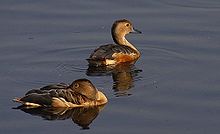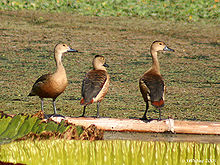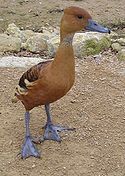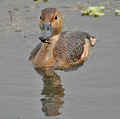- Lesser Whistling Duck
-
Lesser Whistling Duck 
Lesser Whistling Duck in Santragachi Lake, Howrah, IN Conservation status Scientific classification Kingdom: Animalia Phylum: Chordata Class: Aves Order: Anseriformes Family: Anatidae Subfamily: Dendrocygninae Genus: Dendrocygna Species: D. javanica Binomial name Dendrocygna javanica
(Horsfield, 1821)The Lesser Whistling Duck Dendrocygna javanica, also known as Indian Whistling Duck, is a small whistling duck which breeds in South Asia and southeast Asia. It may also be called the Lesser Whistling Teal (based on an older classification), or the Tree Duck.[2]
Contents
Distribution
This is a largely resident species distributed unevenly from the Pakistan lower river valleys eastwards across most of peninsular India, Nepal terai, Sri Lanka, Bangladesh, Burma, Thailand, Malaysia, Singapore, Indonesia, south China, to Vietnam. It is largely resident, apart from local movements (often induced by drought or floods), but Chinese birds winter further south.
Covering between 1 to 10 million km², it is estimated to have a global population of between two and twenty million individuals.[1]
Habitat: still freshwater lakes, with plentiful vegetation, where this duck feeds on seeds and other vegetation. Occasionally seeks refuge in the ocean just outside the surf area.[3]
May be seen often perching on trees near water bodies, giving rise to the alternate name Tree Duck.
Description
This species has a long grey bill, long head and longish legs. It has a buff head, neck and underparts, and a darker crown. The back and wings are darkish grey, and there are chestnut patches on the wings and tail. All plumages are similar.
This species is gregarious, and at favoured sites, such as Carambolin Lake in India, the flocks of a thousand or more birds arriving at dawn are an impressive sight.
The call is a wheezy, whistling "seasick, seasick", call, uttered in flight.[3] Roosts can be quite noisy.
Nesting
It nests in tree holes, old nests of other birds, or on a stick platform near the ground, and lays 6-12 eggs.
References
- ^ a b BirdLife International (2004). Dendrocygna javanica. 2006. IUCN Red List of Threatened Species. IUCN 2006. www.iucnredlist.org. Retrieved on 11 May 2006. justification for least concern: global population of between two and twenty million individuals (Wetlands International 2002).
- ^ Grewal, Bikram; Bill Harvey and Otto Pfister (2002). Photographic guide to birds of India. Periplus editions / Princeton University Press. p. 58
- ^ a b Ali, Salim; Sidney Dillon Ripley (1986/2001). Handbook of the Birds of India and Pakistan, 2nd ed.,10 vols (2nd ed.). Oxford University Press.Bird Number 138, vol. 1, p. 138-140.
Other References
- Wildfowl by Madge and Burn, ISBN 0-7470-2201-1
- Birds of Goa (video)
Behaviour, habits, views etc.
-
Resting in Kolkata, West Bengal, India.
-
After bath in Kolkata, West Bengal, India.
-
After bath in Kolkata, West Bengal, India.
-
After bath in Kolkata, West Bengal, India.
-
Preening & Allopreening in Hyderabad, India.
-
Resting in a lake in Kolkata, West Bengal, India.
-
Resting in Kolkata, West Bengal, India.
-
Resting hidden inside the foliage in Kolkata, West Bengal, India.
-
Resting and Landing in Kolkata, West Bengal, India.
-
Playing in Kolkata, West Bengal, India.
-
Playing in Kolkata, West Bengal, India.
-
About to land in Kolkata, West Bengal, India.
-
In a Lotus pond in Kolkata, West Bengal, India.
-
In a Lotus pond in Kolkata, West Bengal, India.
-
Resting in Hyderabad, India.
Categories:- IUCN Red List least concern species
- Dendrocygninae
- Birds of Asia
- Birds of Bangladesh
- Birds of Brunei
- Birds of Cambodia
- Birds of China
- Birds of India
- Birds of Indonesia
- Birds of Japan
- Birds of Laos
- Birds of Malaysia
- Birds of Burma
- Birds of Nepal
- Birds of Pakistan
- Birds of Singapore
- Birds of Sri Lanka
- Birds of Taiwan
- Birds of Thailand
- Birds of Vietnam
- Birds of Southeast Asia
Wikimedia Foundation. 2010.

















